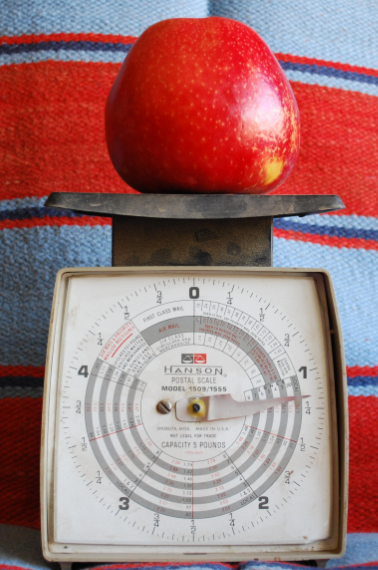
Photograph by John Hultquist
courtesy University of Minnesota
http://www.honeycrisp.org/hcrisp.htm
Honeycrisp is a moderately vigorous tree with a somewhat spreading growth habit. It appears to be well suited to a central leader training system, although the leader may require staking or some fruit removal because of early bearing. The tree is a reliable annual bearer and has shown good precocity (Botany Blossoming before the appearance of leaves.) on dwarf rootstock.
Honeycrisp apples are oblate to roundly oblate in shape and 2-3/4 to 3-1/2 inches (7 to 9 centimeters) in diameter. Stems are approximately 1 inch (2.5 centimeters) long and moderately stiff. Skin color is 60 to 90 percent distinctive mottled red over a yellow background. A nearly solid red coloration develops only if the fruit is well exposed to the sun. The fruit surface has shallow dimples and numerous, small lenticels (dots) with green russeting at the stem end.
Honeycrisp fruit is characterized by an exceptionally crisp and juicy texture. Its flesh is cream colored and coarse. The flavor is sub-acid and ranges from mild and well-balanced to strongly aromatic, depending on the degree of maturity. It has consistently ranked as one of the highest quality apples in the University of Minnesota sensory evaluations.
Honeycrisp fruit has shown excellent storage characteristics. The outstanding flavor and texture can be maintained for at least six months in refrigerated storage without atmosphere modification.
Performance
Honeycrisp apple's harvest season ranges from September 15 to October 10 in east central Minnesota. Optimum harvest usually occurs in the fourth week of September, approximately one week after McIntosh and 2-1/2 weeks before Red Delicious. Earlier harvested apples are generally mild in flavor, while fruit from later harvest dates may be strongly aromatic.
Honeycrisp apples ripen evenly and hold well on the tree. They can be harvested over an extended period or in a single picking. Although fruit adherence is usually good, trees with excessive crops may show some fruit drop. Thinning of heavy crops is advised since overcropping may also adversely affect flavor and fruit quality.
Honeycrisp blooms in the early to middle part of the apple flowering period. It produces viable pollen that has successfully fertilized numerous other cultivars in experimental hand pollinations.
Honeycrisp does not carry any known exceptional resistances to diseases or insects. Apple scab and cedar apple rust lesions have been observed on the leaves but these diseases have been readily controlled with a standard spray program. It has shown moderate susceptibility to fireblight. Supplemental applications of calcium may be useful in preventing bitter pit.
Origin
Honeycrisp was produced from a 1960 cross of Macoun and Honeygold, as part of the University of Minnesota apple breeding program to develop winter hardy cultivars with high fruit quality. The original seedling was planted in 1962 at the University of Minnesota Horticultural Research Center, located near Excelsior in east central Minnesota. It was selected in September 1974 and evaluated as MN 1711 at locations in Excelsior, Morris and Grand Rapids, Minnesota, and at Geneva, New York.